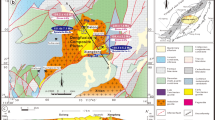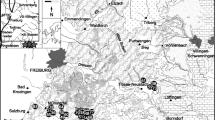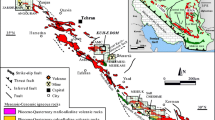Abstract.
Intrusion-hosted, low sulfide, sheeted vein systems are common within many plutons and stocks of the middle Cretaceous Tombstone–Tungsten magmatic belt, Yukon Territory, and host significant gold mineralization. Fluid inclusion characteristics of five such systems, namely Emerald Lake, Dublin Gulch, Scheelite Dome, Mike Lake, and MacTung, constrain the vein-forming fluid composition, formation temperatures and pressures, hydrothermal fluid processes, and potential fluid sources. The veins contain a wide range of fluid inclusion types. Ubiquitous type 1A and 1B inclusions are low salinity (1A: XNaCl<0.02; 1B: XNaCl<0.03), CO2-rich (1A: XCO2=0.18–1.00; 1B: XCO2=0.02–0.33). Laser Raman studies indicate that type 1A and 1B inclusions commonly contain minor CH4 (XCH4<0.09) and N2 (XN2<0.12). Type 2 inclusions are H2O-rich (XH2O=0.94–0.99), of low to moderate salinity (XNaCl=0.01–0.06), and were common at Emerald Lake and Dublin Gulch, in addition to localized type 3A halite-bearing inclusions (XNaCl=0.12–0.16). Both inclusion types post-dated the CO2-rich inclusions. Sheeted veins in the Mike Lake pluton contained coexisting type 1A and 3A and 3B (halite + sylvite) inclusions. Type 1A inclusions in all studied systems homogenized between 208 and 362 °C, type 1B ranged between 205 and 329 °C, and type 2 between 154 and 261 °C. Type 3A and 3B inclusions homogenized between 217 and 355 °C. A predominantly magmatic source for both CO2-rich and saline H2O-rich fluids is favored, with variations in trapping pressure (<1 kbar at Mike Lake, >1 kbar at Emerald Lake and Dublin Gulch, and >2 kbar at MacTung and Scheelite Dome) that potentially control fluid composition and evolution. A variety of fluid processes may have been responsible for gold precipitation including immiscibility and/or release of an evolving magmatic fluid.
Similar content being viewed by others
Author information
Authors and Affiliations
Additional information
Electronic Publication
Rights and permissions
About this article
Cite this article
Baker, T., Lang, J.R. Fluid inclusion characteristics of intrusion-related gold mineralization, Tombstone–Tungsten magmatic belt, Yukon Territory, Canada. Min Dep 36, 563–582 (2001). https://doi.org/10.1007/s001260100189
Received:
Accepted:
Issue Date:
DOI: https://doi.org/10.1007/s001260100189




